Acer Nitro 5 review (AN517-55 model – budget gaming laptop)
This is our detailed review of the 2022 Acer Nitro 5, Acer’s budget-level series of performance/gaming laptops.
In the past, Nitro’s offered excellent value in most markets, with one of the better price/features-performance ratios in their niche. In the last two years, though, Acer didn’t quite keep up with the competition and the Nitro lineups lost some of their competitive advantages.
With the 2022 generation, Acer have slightly aesthetically redesigned the Nitro 5 series, updated the IO and screen options, bumped the hardware to the latest Intel/AMD and Nvidia specs available to date, and also updated the cooling module and the battery.
Throughout this review, we’ll figure out if these updates are enough to make the 2022 Nitro 5 series competitive once more.
We’re looking at a top-tier 17-inch Nitro 5 AN517-55 version powered by an Intel 12th gen Core i7 processor and an RTX 3070Ti graphic chip, alongside the QHD wide-gamut display option. The majority of our findings apply to all the other configurations, though, and we’ll follow up with more reviews of other Nitro 5 variants in the near future.
Update: The initial article did not properly acknowledge the fact that there’s a MUX in the 2022 Nitro, which has been enabled as per the BIOS available in late-March. At the time of our article, our unit did not offer the dGPU MUX option, and that impacted some of our gaming results, as explained in the article. I’ll update if/when I get to retest with the more recent BIOS.
The specs sheet as reviewed– Acer Nitro 5 AN517-55
Acer Nitro 5 AN517-55 2022 gaming laptop
Screen
17.3 inch, 2540 x 1440 px resolution, IPS, 165 Hz, matte, BOE NE173QHM-NY6 panel
Processor
Intel Alder Lake, Core i7-12700H, 6C+8C/20T
Video
Intel Iris Xe + up to Nvidia GeForce RTX 3070Ti Laptop 8GB (100-125W, with Dyn Boost)
without GSync, with MUX (as per March BIOS update, to be clarified)
Memory
16 GB DDR4-3200 RAM (2x DIMMs)
Storage
2x 1 TB SSD (Samsung PM9A1), 2x M.2 slots
Connectivity
WiFi 6 (Killer AX1650i) with Bluetooth 5.0, Killer E2600 Gigabit Ethernet LAN
Ports
1x USB-A 3.2 gen2 (right), 2x USB-A 3.2 gen1 (left), 1x USB-C with Thunderbolt 4 (without charging), HDMI 2.1, LAN, headphone/mic, Kensington Lock
Battery
90 Wh, 330 W power adapter
Size
404 mm or 15.9” (w) x 279 mm or 11” (d) x 24.9 mm or .98” (h)
Weight
3.05 kg (6.72 lb), 1.35 kg (2.99 lbs) power brick, US version
Extras
4-zone RGB backlit keyboard with NumPad, 2x stereo speakers, HD webcam
Acer offers the 2022 Nitro 5 series in a multitude of configurations and in either 15 to 17-inch screen sizes, both with Intel or AMD hardware. The AMD-based variant of the Nitro 5 AN517-55 (Intel) unit here is the Nitro 5 AN517-42. We’ll cover the other variation in future reviews.
The 15-inch variant of this review model si the Acer Nitro 5 AN515-58.
Update2: In the meantime, Acer offer updated models in this segment, with the 2023 Acer Nitro 16 and Nitro 17 lineups.
Design and exterior
The design of the 2022 Nitro 5 has been slightly updated, but don’t expect a major departure from the previous models.
Plastic is still used for the entire chassis, with a smoother finishing for the lid and a more rugged finish for the interior and underside. Surprisingly, the interior does a solid job at hiding smudges and finger oil for a black design.
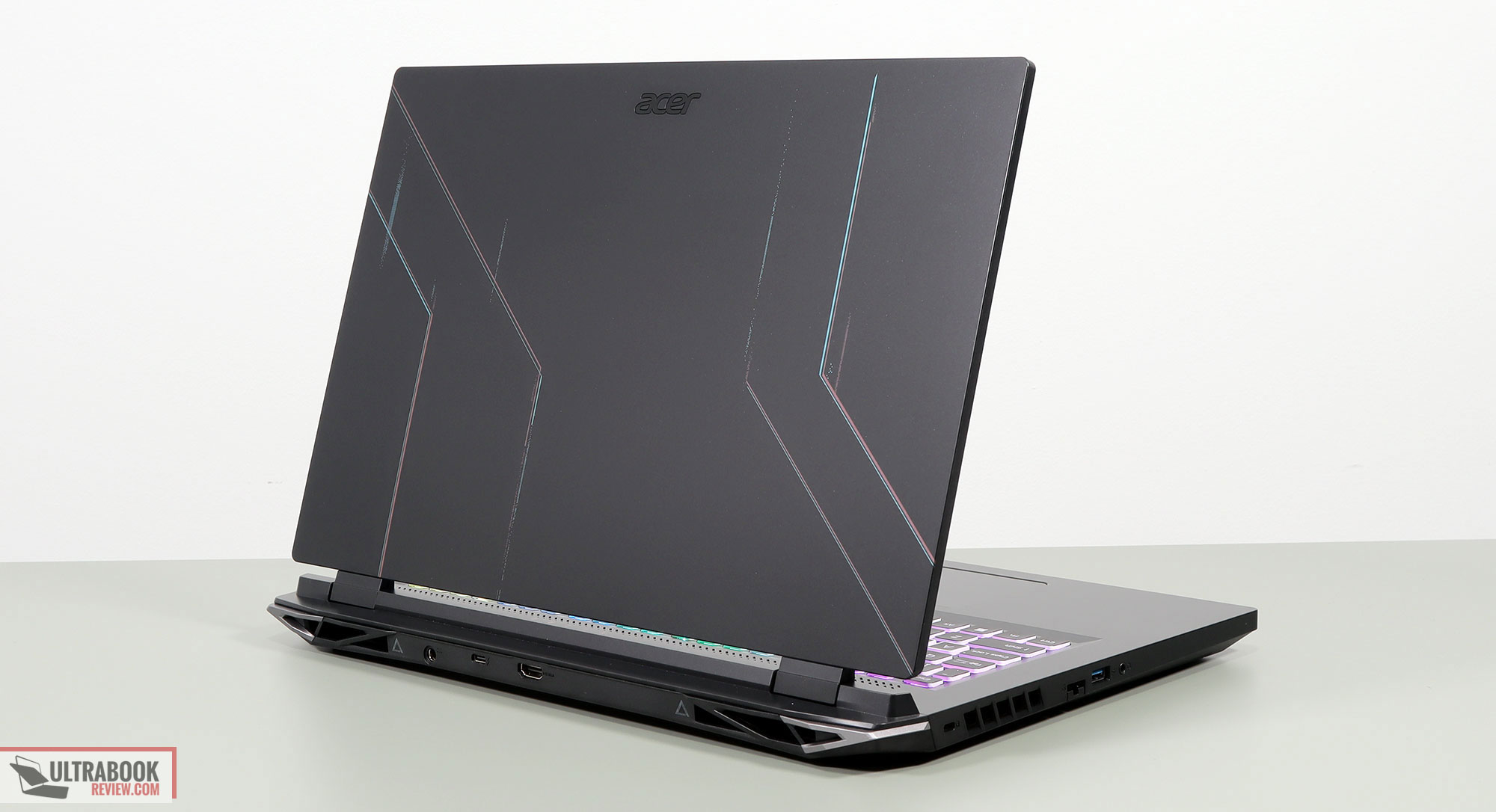
I also appreciate how Acer steered away from their obnoxious branding and design elements of the past, and now went with muted black logos and more subtle design accents on the lid and around the exhausts, on the back edge.
There are a couple of other notable changes, such as the fact that the lid is a little more minimalist and nicer looking now, but also the fact that the screen’s lean-back angle has been increased and that the front lip and corner are no longer as harsh to the wrists as they used to be. Add in the fact that Acer have finally moved the status LEDs from under the screen to the left edge, plus the excellent grip provided on a flat surface by the rubber feet, and the well-balanced IO, and this design ends up being one of the most practical you will find in its niche of budget performance notebooks.
I’ll also add that the cooling design has been updated from the previous generation, with a more ample thermal module on the inside and an extra intake air grille positioned above the keyboard, at the top of the main chassis.
All these aside, though, don’t expect the Nitro 5 to be a premium build or portable in any way. In fact, this 17-inch Nitro 5 series is a full-size computer and weighs 3+ kilos, and you’ll also have to consider the charger when traveling, as this cannot be juiced up via USB-C.
As for the IO, that’s lined on the sides and on the back, with the PSU, HDMI and USB-C port with Thunderbolt 4 support hidden away behind the screen. If Acer were to include an SD card reader and USB-C charging, the IO on this Nitro 5 would have been flawless.
Keyboard and trackpad
The keyboard on this 2022 Nitro 5 is Acer’s standard implementation found on past Nitro and Predator Helios series of the last years.
It’s a full layout with a narrower NumPad section at the right, and full-sized arrow keys, but rather squeezed in between everything else. Layout aside, this is a very good typer, with quiet and precise strokes, and just the right feedback for my typing style. No complaints here.
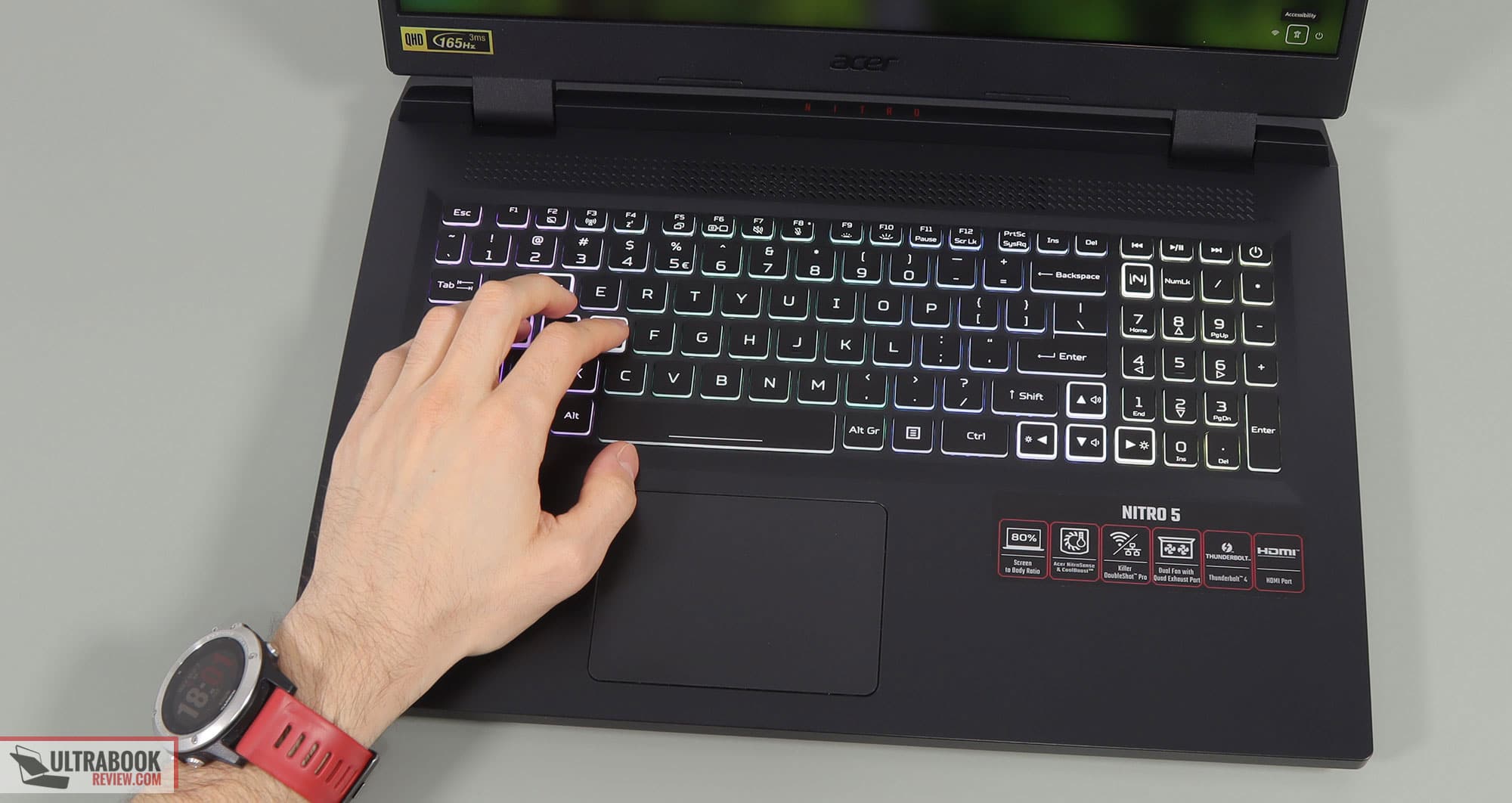
As far as the backlighting goes, the Nitros are available with either red or a 4-zone RGB keyboard, and we have this latter variant here. The RGB zones can be configured from the Nitro Sense app and the LEDs are very bright and clear on the max setting, and there’s even a Caps-Lock indicator, unlike on most other Acer laptops.
What I don’t like is that you still need to press a key to reactivate the lighting once it switches off (if you set it that way in the Nitro Sense app) and the implementation does not allow you to activate the lighting by swiping over the clickpad.
Finally, I’ll add that there are no biometrics on this series.
Screen
Acer offer a couple of different screen options for the 2022 Nitro 5 series, with FHD 144/165Hz options and a QHD 165Hz panel for the higher-tier configurations.
What we have here on this sample is the top-tier 165Hz QHD panel made by AU Optronics. This is well suited for everyday use and gaming, with fast response times and the 165Hz refresh, plus it’s also very well suited for creative work, with the 100% DCI-P3 color coverage.
In fact, this class of panel is a rarity on a budget-level laptop, and it’s the same one usually offered with higher-tier devices such as the ROG Scar 17, Predator Helios 500, or the GE76 Raider. It does have a slight culprit, though, and that’s the fact that it’s only about 300-nits of max brightness, so not ideal for outdoor use or bight office spaces.
Here’s what we got in our tests, with an X-Rite i1 Display Pro sensor:
- Panel HardwareID: BOE BOEOA13 (NE173QHM-NY6);
- Type: 8bit SDR;
- Coverage: 99.9% sRGB, 84.3% AdobeRGB, 99.2% DCI-P3;
- Measured gamma: 2.14;
- Max brightness in the middle of the screen: 318.11 cd/m2 on power;
- Min brightness in the middle of the screen: 22.39 cd/m2 on power;
- Contrast at max brightness: 1210:1;
- White point: 6900 K;
- Black on max brightness: 0.26 cd/m2;
- PWM: No.
This came well calibrated out of the box, with slight Gamma and White point imbalances. Our tests do show a degree of light bleeding and color imbalances between quadrants, though, much like on the Scar 17 that came bundled with this same panel. Hopefully, BOE and Acer get their quality control in check for other retail units, but make sure to run your own tests if you plan to use this laptop for any color-sensitive work.
As far as the FHD panels, I’d expect most Nitro 5 configurations to ship with those instead, and I’d primarily look into the 165Hz FHD option with still 300-nits of brightness, fast response times, and 100% sRGB color coverage. Given our experience with the previous Nitro 5 generation, the 144 Hz base-tier panel might only be 250-nits and ~70% sRGB, so I’d stay away from that one as much as possible.
Hardware and performance
Our test model is a higher-specced configuration of the 2022 Acer Nitro 5, code name AN517-55, built on an Intel Core i7-12700H processor, 32 GB of DDR4-3200 memory in dual channel, 2 TB of fast SSD storage, and dual graphics: the Nvidia RTX 3070Ti dGPU with 8 GB of vRAM and the Iris Xe iGPU integrated within the Intel processor.
Disclaimer: Before we proceed, keep in mind that our review unit was sent over by Acer and it runs on the early software available as of mid-February 2022 (BIOS v0.16T, Nitro Sense 3.01.3034, GeForce Game Ready 511.65 drivers). Certain aspects can change with later software.
Spec-wise, this 2022 Acer Nitro 5 version is built on the latest Intel and Nvidia hardware available to date. The Core i7-12700H is a mainstream Intel Alder Lake 12th-gen processor, with 14 Cores and 20 Threads. It is a hybrid CPU with 6 High-Performance HyperThreaded Cores, and 8 extra Efficiency cores, working together or separate based on demand. The design of this Nitro 5 allows the processor to run at up to 95W of sustained power in demanding CPU loads, on the Performance profile.
For the GPU, the 2022 Nitro 5 series is available with RTX 3000 and RTX 3000 Ti graphics chips. What we have on this sample is an RTX 3070Ti running at up to 125W with Dynamic Boost in supported games and applications.
For the RAM and storage options, the laptop offers two accessible memory DIMMs and two M.2 SSD slots. Our unit shipped with 32 GB of DDR4-3200 RAM in dual-channel and two fast PCIe gen4 Samsung SSDs in Raid0. Given the budget nature of the Nitro 5 series, there’s no DDR5 memory on this unit, but only the previous-gen DDR4. However, as explained in this article, that’s not going to make a significant difference with most loads. I’m also not entirely sure at this point whether the 2022 Nitro 5 is only going to be available with DDR4 memory, or it might also get DDR5 memory in some regions – will update when I know more.
Accessing the components requires taking out the back panel, which is held in place by a couple of Philips screws. Inside you’ll find the RAM and storage slots, the wifi chip, the thermal module, the 90 Wh battery, and the still tiny set of speakers. There’s a fair bit of unused space inside, as this 17-inch Nitro 5 shares a common internal design with the smaller 15-inch variant.
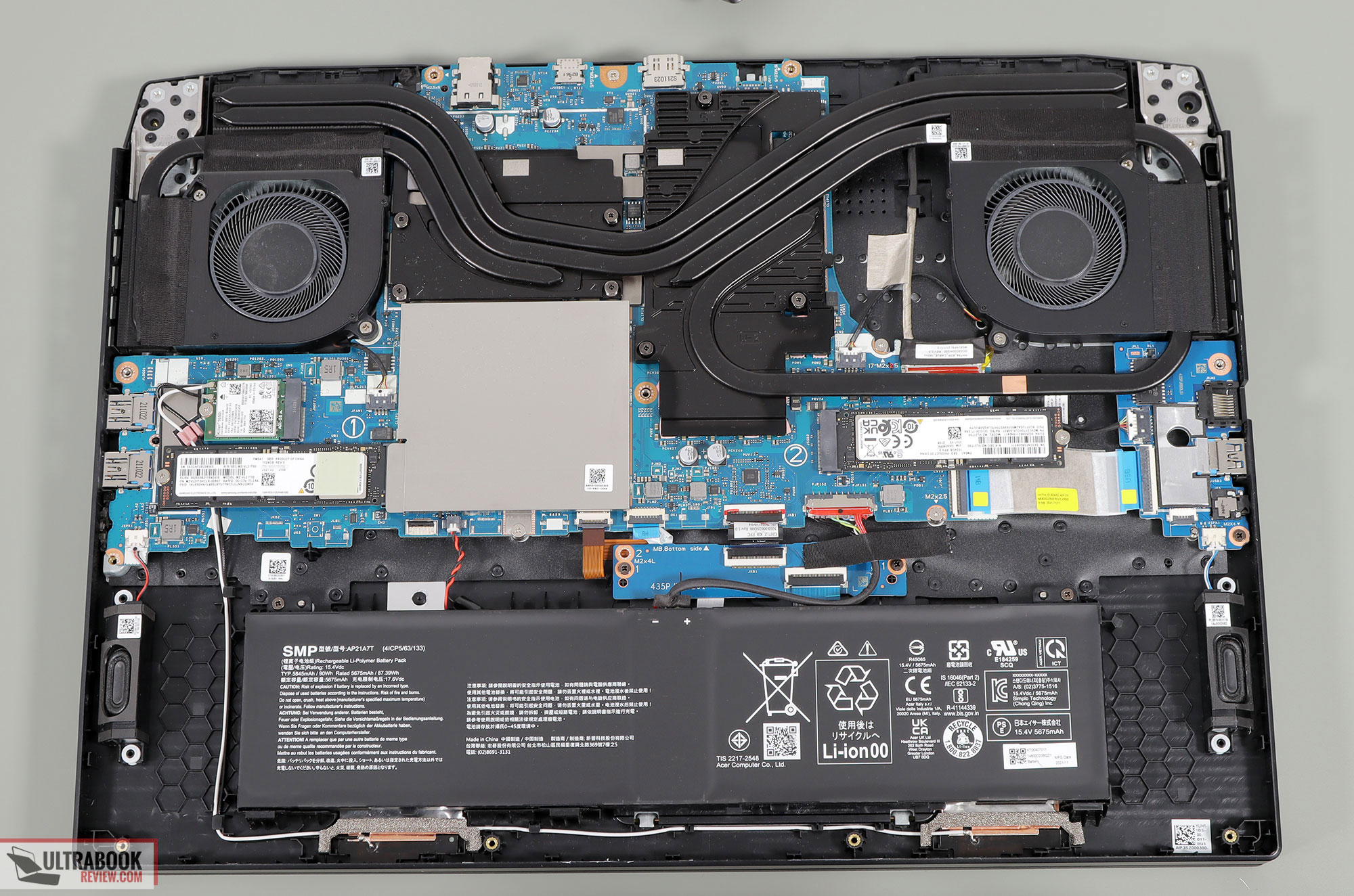
Specs aside, the Nitro 5 is controllable through the included Nitro Sense application, which allows access to power profiles, battery, keyboard, and audio settings. There’s also an Acer Care app that handles updates, as well as a handful of other software – bloatware that comes preinstalled.
The power profiles are Quiet, Default, and Performance, and they impact the fans’ behavior and the CPU/GPU power limits. These profiles are unpolished on this early BIOS version that we have here, and we’ll explain why further down.
For daily use, I’d keep the laptop on Quiet, which still provides a snappy experience, and keeps the fans idle with daily use and light multitasking. Here’s what to expect in terms of performance and temperatures with everyday multitasking, browsing, and video.
Performance and benchmarks
On to more demanding loads, we start by testing the CPU’s performance by running the Cinebench R15 test for 15+ times in a loop, with a 1-2 seconds delay between each run.
The Core i7-12700H processor stabilizes at ~95W of sustained power on the Performance setting, which translates in frequencies of 3.2+ GHz on the P Cores, temperatures of 95-98 C, and scores of ~2400 points. The fans spin at ~58 dB at head-level in this mode, with the current BIOS settings, as the fans are pretty much pushed to their maximum rpms. The CPU runs at even higher power at the 110W PL1 setting for a short while in this test, but thermal and power throttling kick in after a little bit, leading to the stabilized sustained power of 95W.
There’s no undervolting option in the BIOS and voltage control is locked with both XTU and Throttlestop, so there’s no way to tweak the CPU at this point.
Switching over to the Default profile aggressively limits the fans with the current BIOS, as they only spin at 40 dB and around only 20% of their capacity. As a result, the CPU slowly thermally throttles to around 65+W of power on this mode, and scores just under 2200 points.
Acer might decide to update these profiles in the retail Nitros, so I went ahead and manually adjusted the fans at 50% rpms, which is about 48 dB at head-level, and retested. The CPU ends up running at the PL2 80W setting in this case, with temperatures in the higher 80s and scores of 2300 points. These are good results for a potential mid-tier profile.
There’s also a Quiet profile, but it works just like the Default mode on this unit.
Finally, the CPU runs at ~40 W on battery, on the Default profile, with still respectable scores of around 1650+ points. Details below.
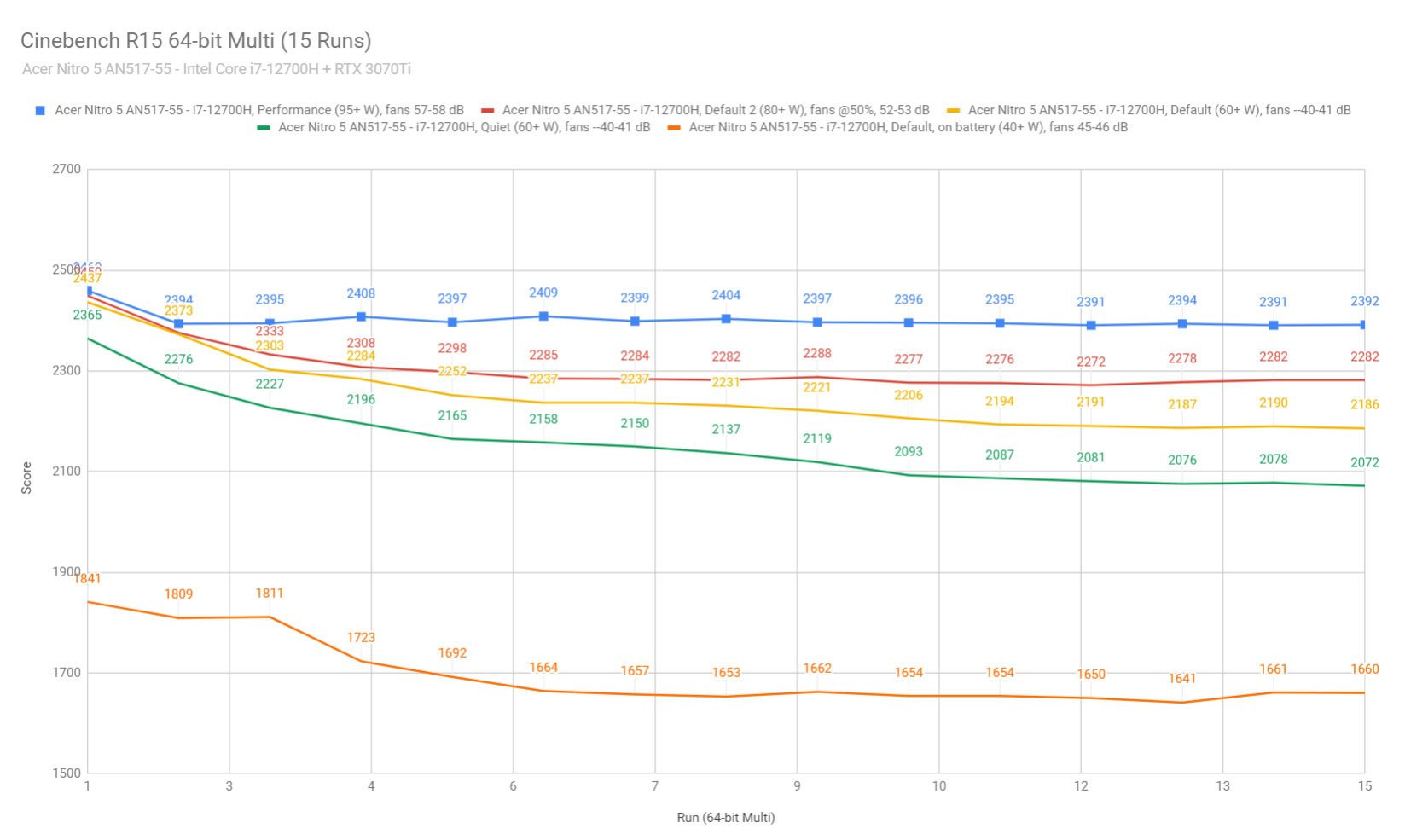
To put these in perspective, here’s how this Core i7-12700H implementation fares against other full-size implementations in this test, both Intel and AMD.
It ends up about 10% slower than the Core i9-12900H in a higher-power and superiorly cooled chassis, and significantly faster than any of the 2021 platforms.
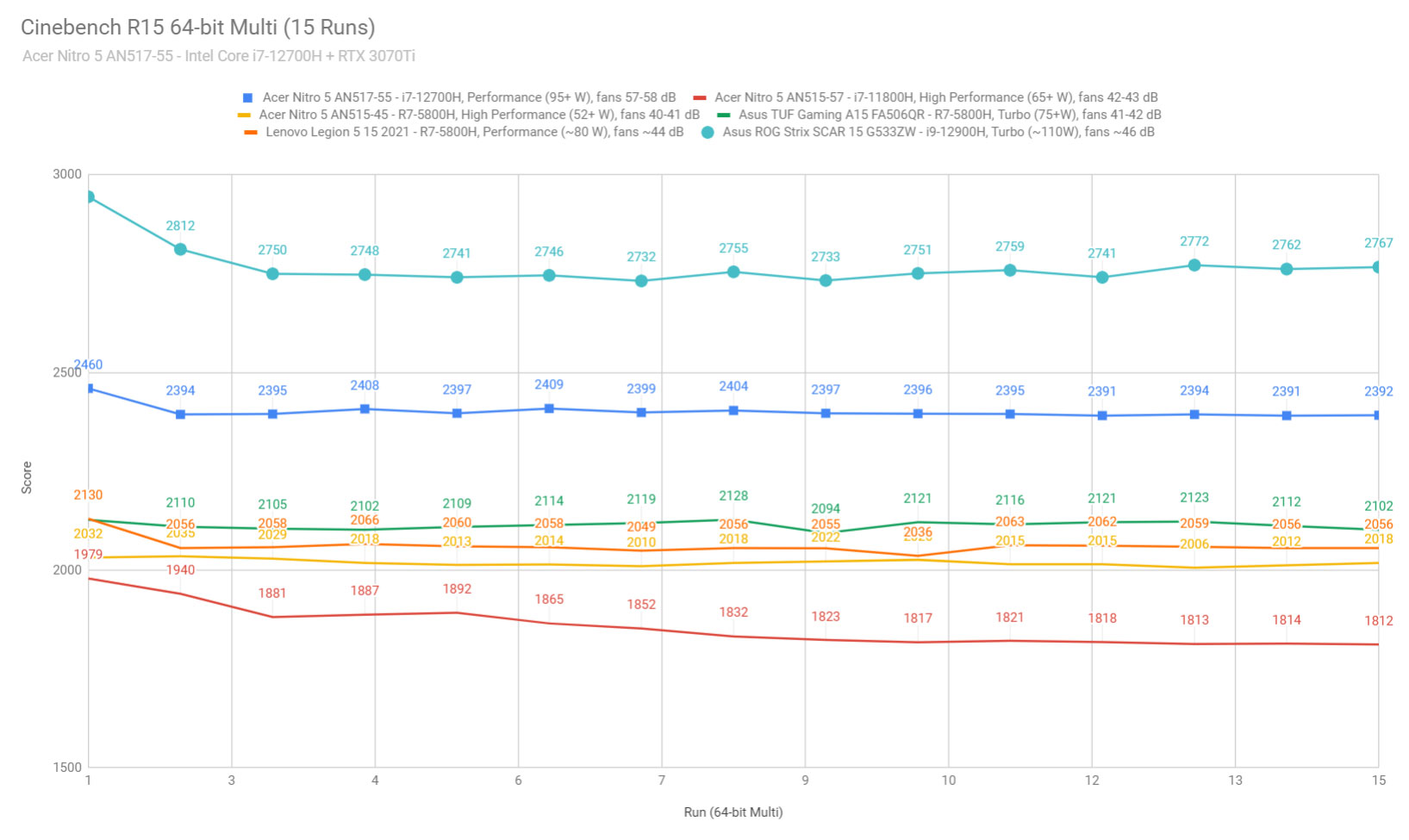
We also ran the 3DMark CPU test on the Performance and Default profiles.
We then went ahead and further verified our findings with the more taxing Cinebench R23 loop test and Blender – Classroom, which resulted in similar findings to what we explained above.
Finally, we ran our combined CPU+GPU stress tests on this notebook. 3DMark stress runs the same test for 20 times in a loop and looks for performance variation and degradation over time, and this unit passed it just fine, which means there’s no performance throttling with longer-duration sustained loads.
Next, we ran the entire suite of tests and benchmarks, on the stock Performance profile in Nitro Sense, and on FHD resolution for consistency with our other tests.
- 3DMark 13 – Fire Strike: 23054 (Graphics – 29034, Physics – 27744, Combined – 8239);
- 3DMark 13 – Port Royal: 6872;
- 3DMark 13 – Time Spy: 11175 (Graphics – 11175, CPU – 11175);
- Uniengine Superposition – 1080p Extreme: 6911;
- Uniengine Superposition – 1080p Medium: 19143;
- Handbrake 1.3.3 (4K to 1080p encode): 53.85 average fps;
- PassMark 10: Rating: 4468 (CPU mark: 24260, 3D Graphics Mark: 12249, Disk Mark: 31298);
- PCMark 10: 6339 (Essentials – 9227, Productivity – 7807, Digital Content Creation – 9599);
- GeekBench 5.4.3 64-bit: Single-Core: 1414, Multi-core: 10802;
- CineBench R15 (best run): CPU 2489 cb, CPU Single Core 248 cb;
- CineBench R20 (best run): CPU 6046 cb, CPU Single Core 534 cb;
- CineBench R23: CPU 17198 cb (best single run), CPU 17012 cb (10 min run), CPU Single Core 1414 cb;
- x265 HD Benchmark 64-bit: 25.55 s.
As a head-up, the single-core CPU results are skewed on this sample with the tested BIOS, and ~20% lower than the platform would be capable of. However, the multi-core and the GPU tests are on-par with what you should expect from the retail models.
Compared to the higher-power i9+RTX 3070Ti 150W configuration tested in the ROG Scar 17, this Nitro implementation ends up about 10-15% slower in the CPU tests, and surprisingly close in most of the GPU tests, despite the fact the 3070Ti in this one runs at only up to 125W.
Furthermore, compared to the 2021 Nitro 5 in an Intel Core i7-11800H + RTX 3070 85W configuration, this updated 2022 variant ends up 20-30% faster in the CPU tests, and 15-20% faster in the GPU loads.
And here are some workstation benchmarks, on the same Performance profile:
- Blender 2.93 – BMW Car scene- CPU Compute: 2m 35s (Turbo);
- Blender 2.93 – BMW Car scene- GPU Compute: 34s (CUDA), 18s (Optix);
- Blender 2.93 – Classroom scene – CPU Compute: 7m 19s (Turbo);
- Blender 2.93 – Classroom scene – GPU Compute: 2m 18s (CUDA), 1m 0s (Optix);
- Pugetbench – DaVinci Resolve: 980 points;
- Pugetbench – Adobe Afert Effects: 743;
- Pugetbench – Adobe Photoshop: 921;
- Pugetbench – Adobe Premiere: 816;
- SPECviewperf 2020 – 3DSMax: 101.06 (Turbo);
- SPECviewperf 2020 – Catia: 68.72 (Turbo);
- SPECviewperf 2020 – Creo: 85.68 (Turbo);
- SPECviewperf 2020 – Energy: 23.59 (Turbo);
- SPECviewperf 2020 – Maya: 308.09 (Turbo);
- SPECviewperf 2020 – Medical: 33.56 (Turbo);
- SPECviewperf 2020 – SNX: 21.13 (Turbo);
- SPECviewperf 2020 – SW: 229.98 (Turbo).
- V-Ray Benchmark: CPU – 10306 vsamples, GPU CUDA – 1253 vpaths, GPU RTX – 1519 vpaths;
Once more, this i7+3070Ti 2022 configuration is a close contender to the higher-power implementation in the Scar 17, with the reserve that some of the single-score CPU loads are skewed and not as high as the 12th gen i7-12700H would be capable of with finalized software. That’s affecting the Adobe Photoshop and After Effects scores, among others.
Now, all these are excellent results, but the laptop does run at ~58 dB on this Performance profile, so there might be situations when you’d prefer sacrificing the performance for quieter fan noise. Here’s how this 2022 Nitro 5 performs on the Default profile, which limits the fans to around 40 dB at head level on the Auto setting – that’s only about 205 of their rpms.
- 3DMark 13 – Fire Strike: 22391 (Graphics – 26331, Physics – 23460, Combined – 10223);
- 3DMark 13 – Time Spy: 10261 (Graphics – 10304, CPU – 10027);
- Uniengine Superposition – 1080p Extreme: 6740;
- GeekBench 5.4.3 64-bit: Single-Core: 1441, Multi-core: 11630;
- CineBench R15 (best run): CPU 1565 cb, CPU Single Core 207 CB;
- CineBench R23: CPU 15887 cb (best single run), CPU Single Core 1416 cb;
- Pugetbench – Adobe Photoshop: 881;
- Pugetbench – Adobe Premiere: 782;
The CPU scores take a 10-15% hit compared to the Performance profile, while the GPU scores only drop by about 5%. However, it’s important to acknowledge that all the components are going to run at their thermal limits on this stock Default mode, and both he CPU and GPU are thermally throttled.
I’d expect Acer to tweak the Default profile on the retail models, and if they don’t, you should consider manually setting up the fans in the Nitro sense app somewhere in between 30-50% rpms (42 to 48 dB), for a safer balance of temperatures and noise levels.
Gaming performance
The Nitro 5 is a gaming computer at its core, so let’s see how it handles modern titles.
We tested several games at QHD and FHD resolution on Ultra settings, on the stock Performance and Default profiles, but also on a Default profile with the fans manually set at 50%, for the reasons explained in the previous section.
For what is worth, take these findings with a grain o salt, because of the early state of the drivers on this laptop.
Update: MUX support has been added to the 2022 Nitro 5 lineup as of the mate-march 2022 BIOS update. At the time of this review, out unit did not support a MUX, so these tests are running on the Hybrid mode. That means you should expect 3-10% higher scores at QHD resolution and up to 15% higher framerates at FHD resolution on the retail models, with the working MUX.
Intel Core i7-12700H
+ RTX 3070Ti Laptop 115-125W
QHD Performance
QHD Default
QHD Default, fans 50%
FHD Performance
Battlefield V
(DX 12, Ultra Preset, RTX OFF)
114 fps (63 fps – 1% low)
88 fps (53 fps – 1% low)
108 fps (65 fps – 1% low)
142 fps (74 fps – 1% low)
Cyberpunk 2077
(DX 12, Ultra Preset, RTX OFF)
42 fps (32 fps – 1% low)
36 fps (30 fps – 1% low)
40 fps (32 fps – 1% low)
65 fps (48 fps – 1% low)
Far Cry 6
(DX 12, Ultra Preset, TAA)
78 fps (45 fps – 1% low)
66 fps (41 fps – 1% low)
72 fps (46 fps – 1% low)
82 fps (47 fps – 1% low)
Far Cry 5
(DX 11, Ultra Preset, SMAA)
100 fps (49 fps – 1% low)
88 fps (42 fps – 1% low)
96 fps (47 fps – 1% low)
116 fps (55 fps – 1% low)
Shadow of Tomb Raider
(DX 12, Highest Preset, TAA)
83 fps (52 fps – 1% low)
70 fps (47 fps – 1% low)
80 fps (50 fps – 1% low)
86 fps (53 fps – 1% low)
The Witcher 3: Wild Hunt
(DX 11, Ultra Preset, Hairworks On 4)
104 fps (52 fps – 1% low)
81 fps (43 fps – 1% low)
95 fps (46 fps – 1% low)
128 fps (54 fps – 1% low)
- Battlefield V, The Witcher 3 – recorded with Fraps/in-game FPS counter in campaign mode;
- Far Cry 5, Middle Earth, Strange Brigade, Red Dead Redemption 2, Tomb Raider games – recorded with the included Benchmark utilities;
- Red Dead Redemption 2 Optimized profile based on these settings.
Those above are rasterization tests, and here are some results for RTX titles.
Intel Core i7-12700H
+ RTX 3070Ti Laptop 115-125W
QHD Perf
FHD Perf
Battlefield V
(DX 12, Ultra Preset, RTX ON, DLSS OFF)
75 fps (480 fps – 1% low)
103 fps (72 fps – 1% low)
Cyberpunk 2077
(DX 12, Ultra Preset + RTX, DLSS Auto)
45 fps (36 fps – 1% low)
57 fps (45 fps – 1% low)
Shadow of Tomb Raider
(DX 12, Highest Preset, TAA, RTX Ultra)
55 fps (36 fps – 1% low)
66 fps (38 fps – 1% low)
Once more, we’re comparing these with our findings on the higher-power i9 + RTX 3070Ti configuration tested on the Scar 17, and this Nitro 5 ends up very competitive, within 10-15% of that option in most games.
The differences widen at FHD resolution, though, primarily because we ran our tests are on the Hybrid/Optimus mode, which channels the video output through the iGPU to the internal screen. The MUX has been activated with the more recent BIOS version, and you can also circumvent this situation by outputting the video signal onto an external monitor, via the HDMI port that hooks straight into the Nvidia dGPU. I’ll update if I get to retest this with the MUX-capable BIOS update.
Compared to the 2021 Nitro 5, this 2022 generation ends-up about 20% faster in these games, at both QHD and FHD resolution.
With that out of the way, let’s go over some performance and temperatures logs.
As mentioned already, the Performance mode pretty much pushes the fans to their maximum speeds with the current settings, and that allows for competitive temperatures. The GPU runs at around mid-70s Celsius between the tested titles, and close to its 125W design power with Dynamic Boost, and the CPU does run at between low 80 and low 90s between the tested titles, based on the amount of power supplied by the system. I do expect the CPU to run cooler on the retail units once Acer tweak out their drivers and end-up running this Intel platform at lower power than on this sample, as it does on other implementations.
The thermal design is pretty good here, but the feet on the back are still fairly slim and that’s why lifting up the back of the laptop from the desk is going to help lower the internal temperatures by a few degrees.
The stock Default profile is an entirely different story, though.
In this case, the fans are limited to only around 20% of their capacity and fan-noise levels of 40 dB, and that’s causing the internals to heat up. We’re looking at 90+ for the CPU and around 87 on the dGPU, right at the throttling limit. The framerates take a roughly 20% beat as well compared to the Performance profile.
Once more, I switched on the fan control to manual and set up the fans at 50% rpm, which translates to about 48 dB at head level.
On this profile, the CPU still runs fairly hot because the system is not properly able to lower the CPU power with Dynamic Boost. This causes the GPU to only run at around 115W of power, but with OK temperatures in the high 70s.
The framerates end up at about 90-95% of what the system is capable of on Performance, so even if not working as intended, this tweaked Default profile ends up well balanced here.
There’s also the Quiet mode that you can use if you’re planning for sub 40dB gaming with safe temperatures. With Whisper Mode on at 60 fps, the GPU runs at around 60-70 W on this Quiet mode, and temperatures in the 70s. The CPU runs at around 30-40W, and temperatures in the 80s.
Overall, this Nitro 5 is a very compelling implementation of the 2022-generation hardware, even in this early sample with an immature BIOS version. This performs very well, and I expect the retail models to even run a cooler (and maybe even quieter) once Acer better tweaks Dynamic Boost implementation and the ability to lower the CPU power in combined loads.
Noise, Heat, Connectivity, speakers, and others
Acer have updated the thermal design for this 2022 Nitro 5 generation, adding extra heatpipes on both components and improving the airflow into the fans, by adding in the extra admission grills on the inside, above the keyboard.

Paired with the aggressive fan settings, this cooling module is capable of delivering solid performance from the implemented hardware specs, with OK temperatures on most profiles, as explained in the previous section.
The laptop does run very noise on the Performance profile as implemented on this early sample, which pushes the fans to their maximum rpms. This translates in noise levels of 58 dB at head-level, making the laptop only usable with high-quality headphones.
The stock Default mode, on the other hand, aggressively limits the fans at about 20% rpms and 40 dB noise levels, and that leads to high internal and external temperatures.
The better-balanced profile on this sample is Default with the fans manually set on 50% rpm, which offers balanced internal/external temperatures and noise levels of 48 dB.
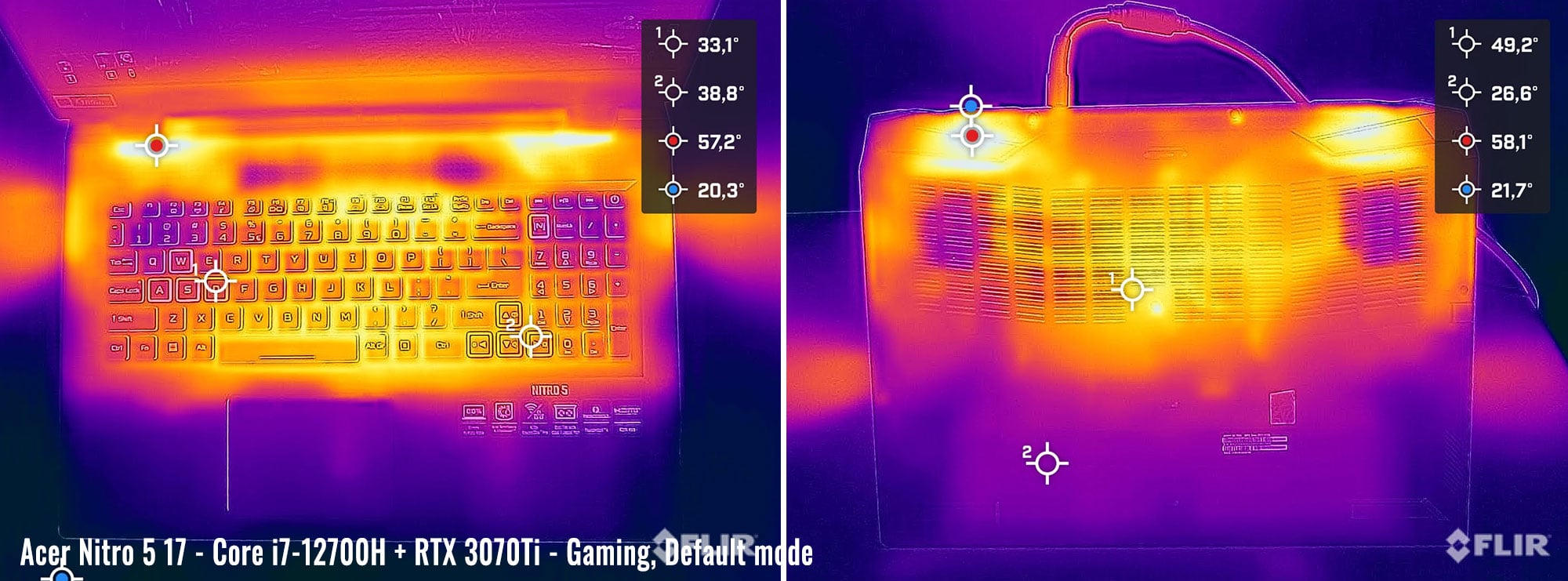
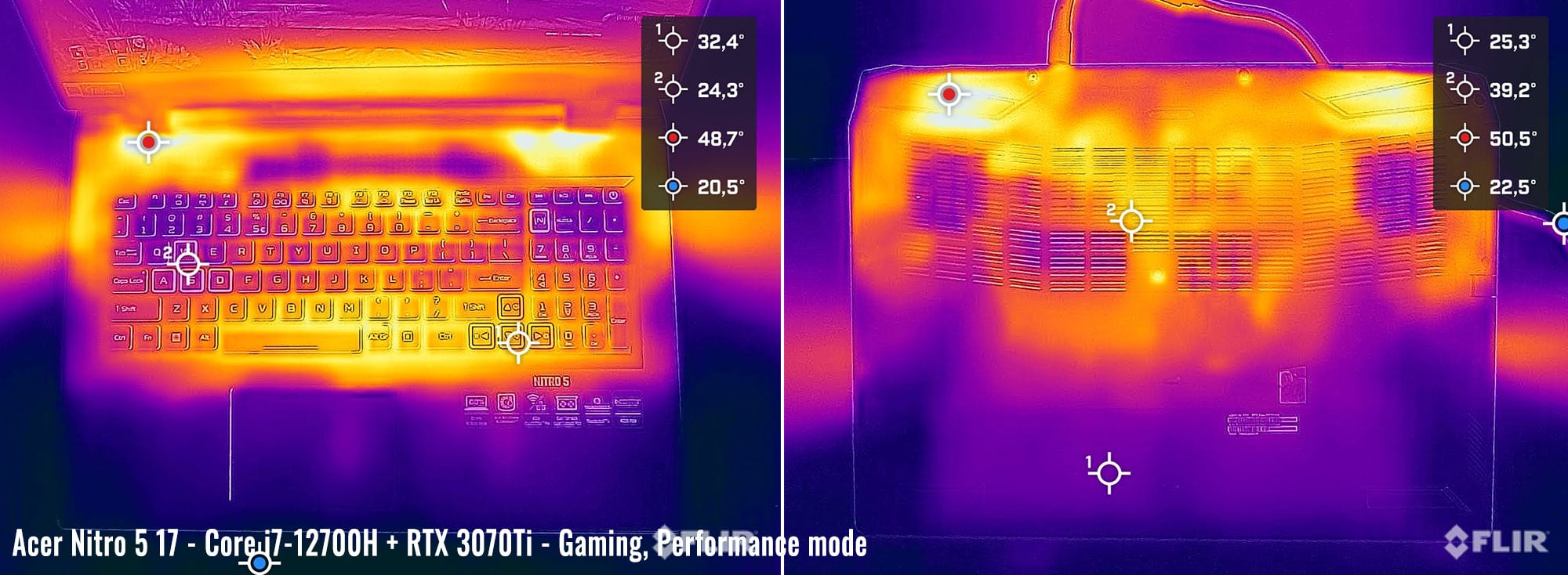
*Gaming – Default – playing Witcher 3 for 30 minutes, fans at ~40 dB
*Gaming – Performance – playing Witcher 3 for 30 minutes, fans at ~58 dB
With daily use, the laptop keeps quiet, with the fans staying idle most of the time.
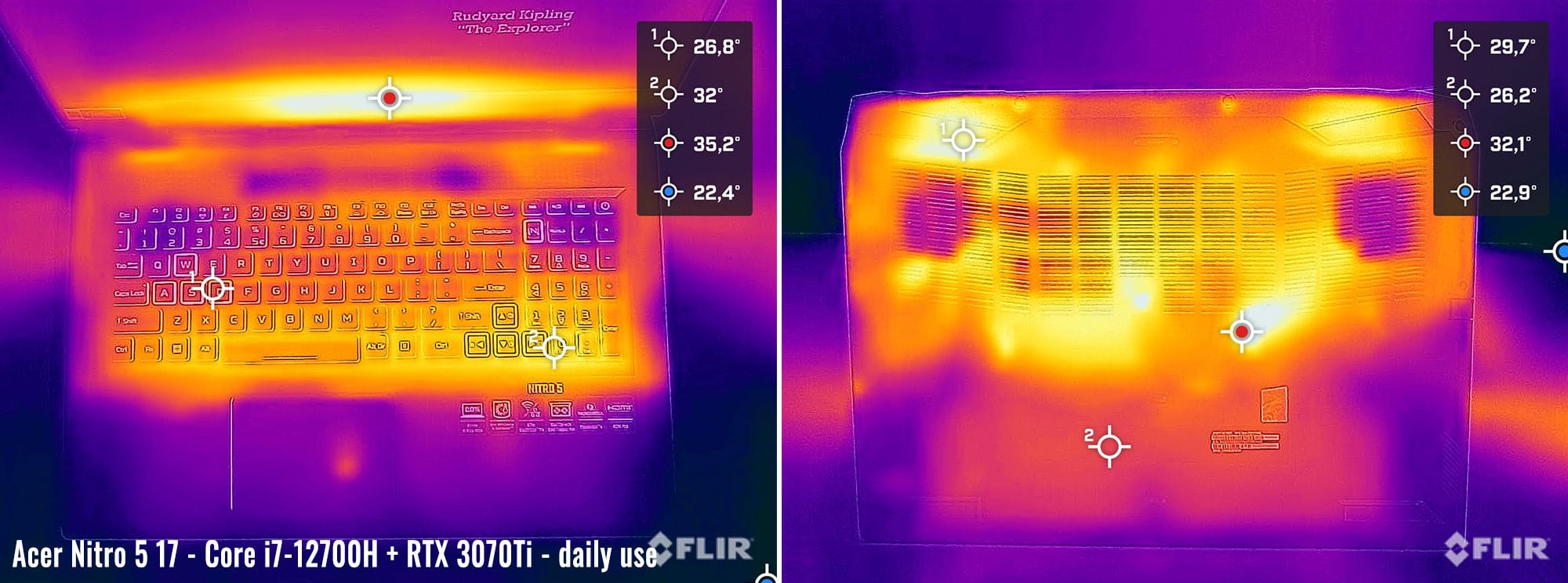
*Daily Use – streaming Netflix in EDGE for 30 minutes, Silent profile, fans at 0 dB
For connectivity, there’s Wireless 6E and Bluetooth 5.2 on this unit, through a Killer Intel-based chip. This is faster than what I’ve seen on 2022 laptops, and hopefully, it is the same chip that will make it on the retail models as well – there’s no guarantee with the current chip shortage, though.
The audio quality is one of the major aspects that Acer haven’t updated for the 2022 Nitro 5. They still put some tiny speakers inside this laptop, and as a result the audio lacks in both volumes and quality. These speakers are perhaps OK for an occasional movie or some music playing in the background, with Enhanced Audio switched on in Windows 11, but the audiophiles among you will definitely have to turn towards some headphones instead.
Finally, there’s the camera, which hasn’t been updated from the previous Nitros either. However, this is actually better quality than what you’ll normally get on low-tier and even mid-range laptops these days, and is placed where it should be, at the top of the screen, flanked by microphones.
Battery life
There’s a 90Wh battery inside this 17-inch 2022 Nitro 5, a step-up from the 58 Wh battery in the previous generations.
Here’s what we got on our review unit in terms of battery life, with the screen’s brightness set at around 120 nits (~60 brightness):
- 14 W (~6-7 h of use) – text editing in Google Drive, Silent Mode, screen at 60%, Wi-Fi ON;
- 17 W (~5-6 h of use) – 1080p fullscreen video on Youtube in Edge, Silent Mode, screen at 60%, Wi-Fi ON;
- 18 W (~5-6 h of use) – Netflix fullscreen in Edge, Silent Mode, screen at 60%, Wi-Fi ON;
- 24 W (~4-5 h of use) – browsing in Edge, Balanced Mode, screen at 60%, Wi-Fi ON.
The system doesn’t automatically switch the screen’s refresh to 60 Hz when using the laptop on battery, so we ran our tests on the default 165Hz refresh. Manually opting for 60Hz would have a slightly positive impact on the runtimes, especially with video and light use.
One other aspect to mention here is that our unit shipped with Acer’s massive 330W charger, which weighs a whopping 1.35 kilos. This is unnecessarily high-capacity for the specs on this laptop, and I hope the retail models will ship with a smaller brick, especially since you’ll have to grab along the main charger in your travels and commute, as USB-C charging is still not supported on this series.

Price and availability- 2022 Acer Nitro 5
The 2022 Nitro 5 series is expected in stores around March of this year, with prices starting at around 1200 USD/EUR for the base configurations.
I haven’t found this in any stores, though, so I can’t tell you anything about the retail prices for the configuration tested here. Hopefully, these 2022 Nitros are still competitively priced, although the multiple updates will most likely push up the prices higher than on the previous generations.
We’ll update you when we know more. In the meantime, follow this link for updated configurations and prices in your region at the time you’re reading this article.
Final thoughts- Acer Nitro 5 review
With retail prices still an unknown for this 2022 Nitro 5 series, it’s hard to properly judge the competitiveness of the series vs the other options in the budget class of performance and gaming laptops, such as the Asus TUF Gaming (A15 – AMD and F15 – Intel reviews available here), the Lenovo Legion 5, or the Dell Gaming G lineups, among others.
I do expect this generation to go up in price, especially for the configurations with the higher-tier specs, the QHD display, and the 90 Wh battery.
Pricing aside, I’m happy with the incremental updates on this 2022 generation. I appreciate the cleaner and more practical design, the more powerful hardware implementation, and the more capable thermal module. In fact, this review unit performed within 10-15% of the higher-tier and higher-powered ROG Scar 17 tested a few weeks ago, despite the fact that it’s not running on finalized software. It did run very noise on the max-Performance profile, though, but I cannot tell for sure if that’s to be expected from the finalized units as well, or perhaps some better-tweaked profiles.
I’ll also add that Acer offer this 2022 Nitro series in both Intel and AMD configurations, with this Intel one more being more capable in CPU-heavy loads, but with the AMD options more efficient and capable of longer runtimes. For most buyers, I expect those AMD versions to make the most sense, if available and competitively priced in your area – I look forward to testing those as well.
As for the culprits of this series, potential buyers would have to accept their full-size nature, especially on this 17-inch model that weighs 3+ kilos, their all-plastic constructions, the lack of USB-C charging, and the poor audio quality, on top of the noisy fans aspects already mentioned. None of these are surprising for this segment, and should not be a deal-breaker as long as this Nitro 5 series is competitively priced in your area.
Finally, as far as the competition goes, the Nitro 5 will have to face competitive alternatives such as the Asus TUF Gaming series, Lenovo Legion 5, or the HP Omen 15 lineup, among others.
This pretty much wraps up our review of the 2022 Acer Nitro 5 series. I’d love to hear your thoughts and feedback down below, and don’t hesitate to get in touch for any questions.
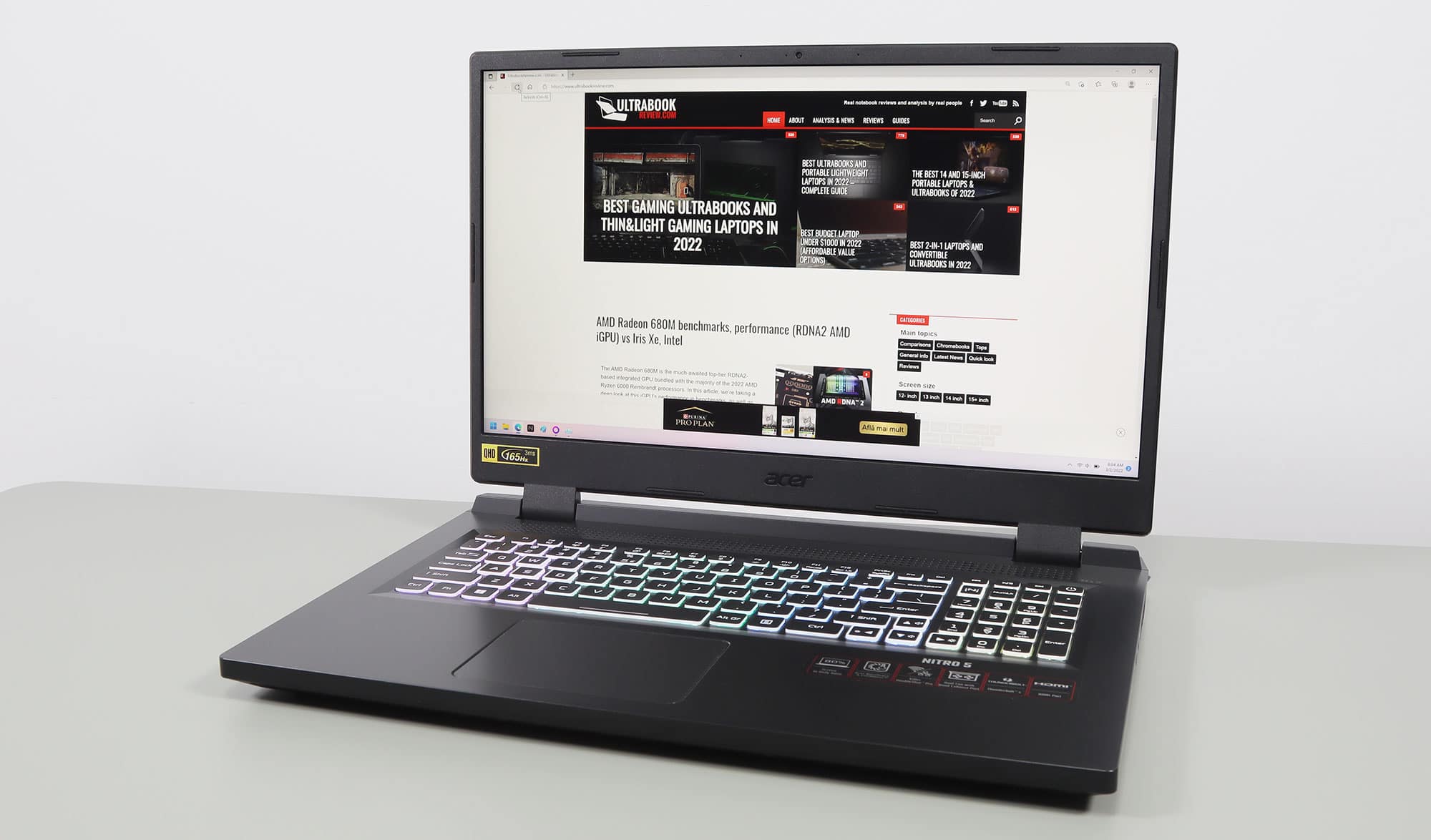
Disclaimer: Our content is reader-supported. If you buy through some of the links on our site, we may earn a commission.
Navigation: Ultrabookreview.com » 15.6 inch or larger
Our content is reader-supported. If you buy through some of the links on our site, we may earn a commission. Terms


Review by: Andrei Girbea
Andrei Girbea, Editor-in-Chief. I’ve a Bachelor’s in Computer Engineering and I’ve been covering mobile technology since the 2000s. You’ll mostly find reviews and thorough guides written by me here on the site, as well as some occasional first-impression articles.
. I’ve a Bachelor’s in Computer Engineering and I’ve been covering mobile technology since the 2000s. You’ll mostly find reviews and thorough guides written by me here on the site, as well as some occasional first-impression articles.






